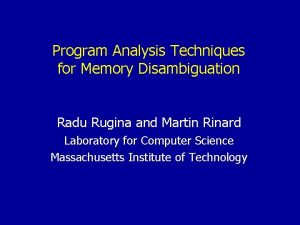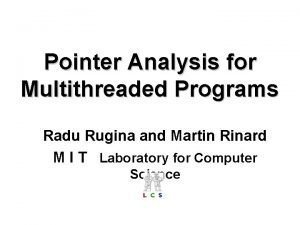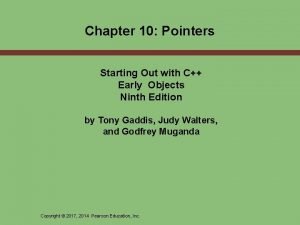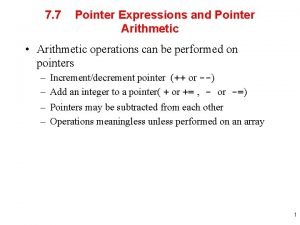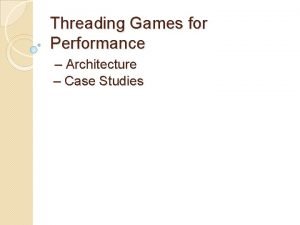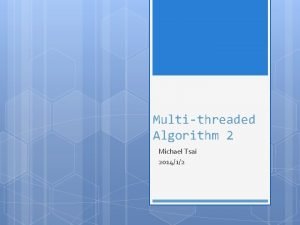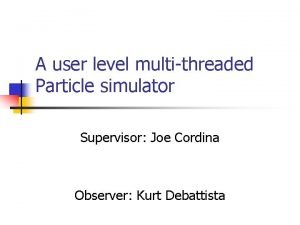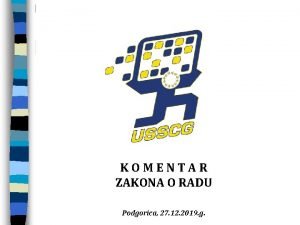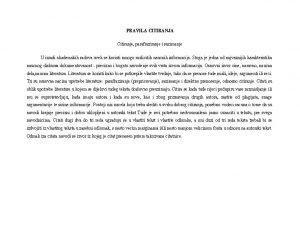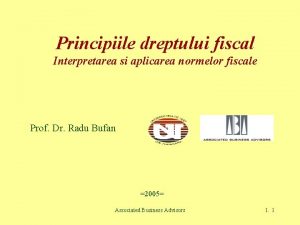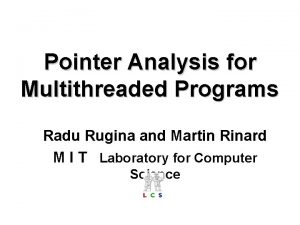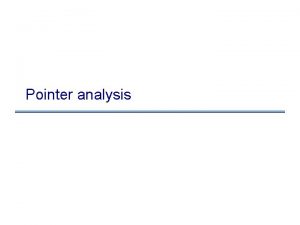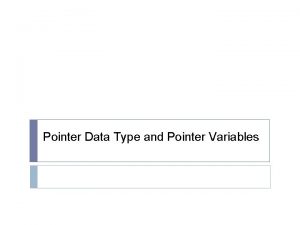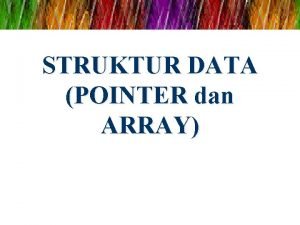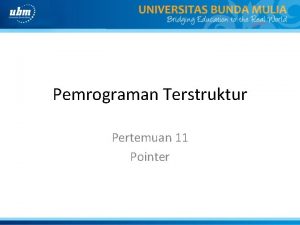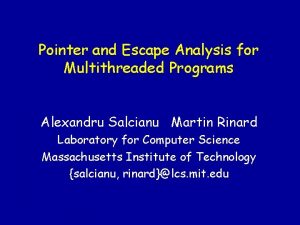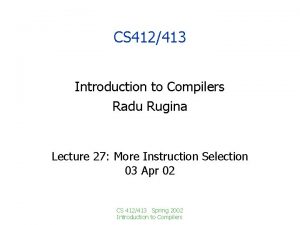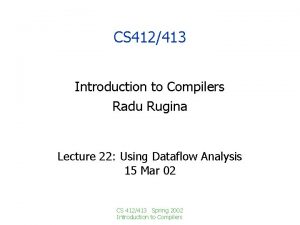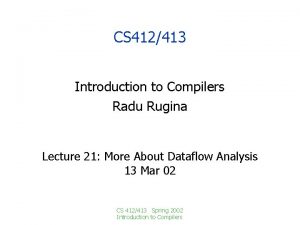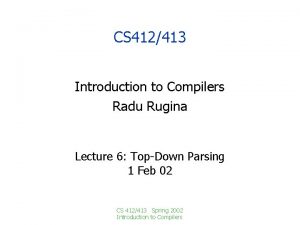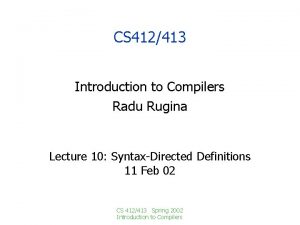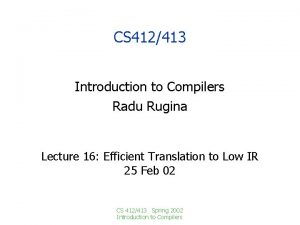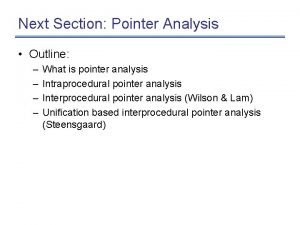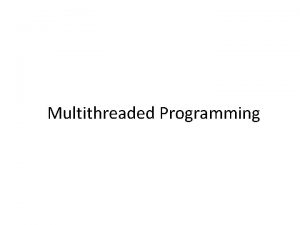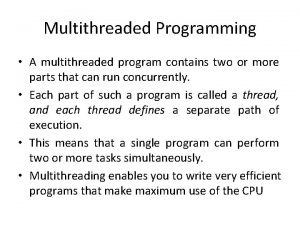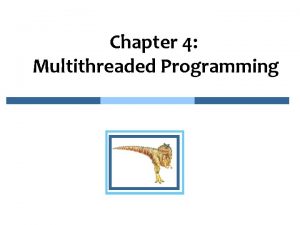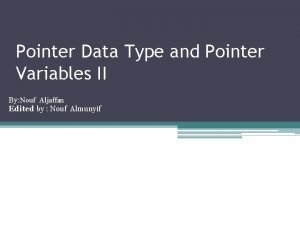Pointer Analysis for Multithreaded Programs Radu Rugina and









![Points-to Graphs • Points-to graphs [EGH 94] – nodes = program variables – edges Points-to Graphs • Points-to graphs [EGH 94] – nodes = program variables – edges](https://slidetodoc.com/presentation_image/3c47a0982dac0f67f448d2d36f4ae570/image-10.jpg)























- Slides: 33

Pointer Analysis for Multithreaded Programs Radu Rugina and Martin Rinard M I T Laboratory for Computer Science

Outline • Example • Review of Pointer Analysis for Sequential Programs • Pointer Analysis for Multithreaded Programs • Experimental Results • Conclusions R. Rugina, M. Rinard PLDI 99

Example • two concurrent threads • two questions: Q 1 : what location is written by *p=1 ? Q 2: what location is written by *p=2 ? OR : Q 1: p ? in left thread Q 2: p ? after both threads completed R. Rugina, M. Rinard PLDI 99

Two Possible Executions R. Rugina, M. Rinard PLDI 99

Analysis Result = a pointsto graph at each program point R. Rugina, M. Rinard PLDI 99

Analysis of Multithreaded Programs • Problem: – analyze interactions between concurrent threads • Straightforward solution: – analyze all possible interleavings and merge results – fails because of exponential s 1 +. . . +complexity (s 1 +. . . + = – for n threads with s 1 s, 1. . . : , . . . s 1 !s. . . s, nsstatements n n) !sn ! ( ) Number of interleavings = R. Rugina, M. Rinard PLDI 99

Our Approach • We introduce interference information : – interference = points-to edges created by the other concurrent threads – models the effect of “all possible interleavings” • Efficiency: polynomial complexity in program size • Derive dataflow equations : – – recursive equations fixed-point algorithms to solve the equations theoretically less precise than “all interleavings” in practice : no loss of precision R. Rugina, M. Rinard PLDI 99

Algorithm Overview • intra-procedural: – flow-sensitive (dataflow analysis) – handles unstructured flow of control – defines dataflow equations for: • pointer assignments • parallel constructs • inter-procedural : – context-sensitive – handles recursive functions R. Rugina, M. Rinard PLDI 99

Review of Pointer Analysis for Sequential Programs
![Pointsto Graphs Pointsto graphs EGH 94 nodes program variables edges Points-to Graphs • Points-to graphs [EGH 94] – nodes = program variables – edges](https://slidetodoc.com/presentation_image/3c47a0982dac0f67f448d2d36f4ae570/image-10.jpg)
Points-to Graphs • Points-to graphs [EGH 94] – nodes = program variables – edges = points-to relationships • Example : R. Rugina, M. Rinard PLDI 99

Basic Pointer Assignments • Four types of pointer assignments: • • x = &y x=y x = *y *x = y ( address-of assign ) ( copy assign ) ( load assign ) ( store assign ) • More complex assignments: – transformed into a sequence of basic statements *z = &t; tmp = &t; *z = tmp; R. Rugina, M. Rinard PLDI 99

Generated Edges x address-of: z x z y y t x z t u y load: copy: x = &y x z w y t store: x = *y R. Rugina, M. Rinard x=y *x = y PLDI 99

Strong vs. Weak Updates • strong updates : – kill existing points-to relationships – result in more precise analysis results • weak updates : – leave existing points-to edges in place – reasons for weak updates: • control flow uncertainty: • arrays of pointers : R. Rugina, M. Rinard • heap-allocated pointers : y q x p z r if (cond) p = &q; else p = &r; *p = &x; v[i] = &x; p = malloc( sizeof(int*) ) *p = &x; PLDI 99

Dataflow Information address-of: x = &y copy: x = y gen = { (x, y) } gen = { (x, t) | (y, t) C } kill = { (x, z) | (x, z) C } strong = not (array_elem(x) heap(x)) load: x = *y store: *x = y gen = { (x, u) | (y, t) C (t, u) C } gen = { (z, t) | (x, z) C (y, t) C } kill = { (x, z) | (x, z) C } kill = { (z, w) | (x, z) C (z, w) C } strong = not (array_elem(x) heap(x)) strong = { z | (x, z) C } = {v} not (array_elem(v) heap(v)) R. Rugina, M. Rinard PLDI 99

Dataflow Analysis – the dataflow information is : <C, I, E> P 3 • C = the current points-to relationships • I = the interference information from other threads • E = edges created by the current thread – as a set of edges, P 3 is a lattice: • partial order relation = set inclusion • merge operator = set union <C 1, I 1, E 1> <C 2, I 2, E 2> = <C 1 UC 2 , I 1 UI 2, E 1 UE 2> R. Rugina, M. Rinard PLDI 99

Abstract Interpretation = set of points-to graphs, • P • Stat = set of program statements • abstract semantics is defined by a functional : : Stat (P 3 P 3) R. Rugina, M. Rinard PLDI 99

Parallel par Statements • syntax: par { {t 1}, . . . , {tn} } – concurrent execution – interleaving semantics – may be nested • interference: – is the union of points-to edges created by all other concurrent threads – may be different for different concurrent threads R. Rugina, M. Rinard PLDI 99

Analysis of Individual Threads • Interference information: – I = “global” interference - generated by enclosing par’s – Li =“local” interference - generated by current par – E = points-to edges created by the current thread < Ci’ , Iresult ti thread < Ci , Ii , ti : • Analysis i , Ei > =for > Ii = I Li Ci = C L i R. Rugina, M. Rinard PLDI 99

Parend Analysis result : < C’, I’ , E’ > = par < C, I , E> > < Ci’ , Ii , Ei > = ti < Ci , I i , I’ = I E’ = E ( Ei) C’ = Ci’ R. Rugina, M. Rinard PLDI 99

Analysis of Entire par Construct Recursive dataflow equations : Ci = C L i Ii = I Li information flowing INTO par construct < Ci’ , Ii , Ei > = ti < Ci , Ii , > (thread rule) information flowing of par E’ = E ( Ei) OUT construct C’ = Ci’ < C’, I , E’ > = par rule ) R. Rugina, M. Rinard par < C, I , E > PLDI 99 (

Example Analysis R. Rugina, M. Rinard PLDI 99

Inter-Procedural Analysis • Context-sensitive : – procedures re-analyzed at each call site • Ghost variables: – replace variables not in the scope of the procedure – distinguish locals in different activations of recursive functions • Sequential Partial Transfer Functions (Seq-PTFs) [WL 95] – associate a points-to output graph to an input context – can be reused when there is a match for the input context R. Rugina, M. Rinard PLDI 99

Multithreaded Extensions • Multithreaded Input Context = input points-to information + interference information • Multithreaded PTF = = associates output points-to graph + created edges to an input context • Mapping and unmapping : – map the interference information I R. Rugina, M. Rinard – unmap created points-to edges E PLDI 99

Other Parallel Constructs • Parallel for loops – generate a symmetric dataflow equation: for(i=0; i<n; i++) spawn thread(i); sync; t 1 < C U E 1, I U E 1 , > = < C 1’ , I U E 1 , E 1 > • Conditional Thread Creation – merge analysis result with initial pointstospawn graph if (c 1) thread 1(); if (c 2) spawn thread 2(); sync; R. Rugina, M. Rinard C’ = (Ci’ U Ci ) PLDI 99

Advanced Features • Recursive procedures: – result in recursive dataflow equations – fixed-point algorithm to solve recursion • Function pointers: – result in a dynamic call-graph – handled using the computed pointer information – methodology: analyze all possible callees and merge results • Thread-private global variables: – at parbegin nodes: save their values in the parent thread and make them point to unknown in the child threads R. Rugina, M. Rinard – at parend nodes: restore saved values in the PLDI 99 parent thread

Algorithm Evaluation • Soundness : – the multithreaded algorithm conservatively approximates all possible interleavings of concurrent threads’ statements • Termination of fixed-point algorithms: – follows from the monotonicity of the abstract semantics functional • Complexity of fixed-point algorithms: – worst-case size of points-to graphs: O(n 2), where n = | Stat | – n program points imply worst-case O(n 3) iterations – worst-case polynomial complexity: O(n 4) • Precision of analysis: – if the concurrent threads do not (pointer-)interfere then this algorithm gives the same result as the “ideal algorithm” R. Rugina, M. Rinard PLDI 99

Experimental Results • Implementation : – SUIF infrastructure; Cilk benchmarks • Benchmark characteristics : R. Rugina, M. Rinard PLDI 99

Precision Measurements • Pointer values at load/store: – usually unique target: 83 % of the loads 88 % of the stores – few potentially uninitialized pointers – very few pointers with more than two targets • Comparison : – Multithreaded, Interleaved, Sequential: MT Interleaved Seq – results: Multithreaded = Sequential – conclusion: Multithreaded = Interleaved R. Rugina, M. Rinard PLDI 99

Applications • Current Uses: – MIT RAW project • memory disambiguation for static promotion (ISCA 99) • C-to-silicon compiler generating small memories (FCCM 99) – automatic parallelization of divide-andconquer algorithms (PPo. PP 99) • Future Uses: – data race detection in multithreaded programs R. Rugina, M. Rinard PLDI 99 – static elimination of array bounds checks

Future • Multithreaded programs: – are becoming very common – are hard to debug – are hard to analyze • The current algorithm: – gives precise MT pointer information – may be used as a foundation for other MT analyses – gives a framework for other MT analyses R. Rugina, M. Rinard PLDI 99

Additional Slides

Challenging Benchmark Set • Applications Heavily Optimized By Hand – Pousse - timed competition, won ICFP ‘ 98 contest • Pointer Arithmetic • Casts • Divide and Conquer Algorithms – Recursion – Pointers Into Heap-Allocated Arrays – Pointer-Based Data Structures (octrees, hash tables, . . . ) R. Rugina, M. Rinard PLDI 99 – Recursive Linked Data Structures Allocated On Stack

Related Work • Pointer analysis – existing pointer analyses are focused to sequential programs [LR 92], [LRZ 93], [CBC 93], [EGH 94], [Ruf 95], [WL 95], [And 94], [Ste 96], [SH 97] – flow-sensitive vs. flow-insensitive analysis – context-sensitive vs. context-insensitive analysis • Multithreaded program analysis: – relatively unexplored field – flow-sensitive analysis : • dataflow framework for bitvector problems [KSV 96] • does not apply to pointer analysis – flow-insensitive analysis: • trivially model the interleaving semantics of concurrent threads R. Rugina, M. Rinard PLDI 99 • locality analysis [ZH 97] ( uses type-inference techniques)
 Radu rugina
Radu rugina Radu rugina
Radu rugina Constant pointer and pointer to constant
Constant pointer and pointer to constant Pointer of pointer in c
Pointer of pointer in c 9 pointers
9 pointers Pointer constant in c
Pointer constant in c Display the address of intval using cout and intptr.
Display the address of intval using cout and intptr. Pointer expressions and pointer arithmetic in c
Pointer expressions and pointer arithmetic in c Pointer pointer
Pointer pointer Pointer pointer
Pointer pointer Anghel rugina
Anghel rugina Multithreaded programming language
Multithreaded programming language Multithreading program in java
Multithreading program in java Multithreaded games
Multithreaded games Multithreaded algorithms
Multithreaded algorithms Apt multithreaded
Apt multithreaded Cpmcd in software engineering
Cpmcd in software engineering Uputstvo za izradu seminarskog rada
Uputstvo za izradu seminarskog rada Radu mariescu-istodor
Radu mariescu-istodor Cine este radu cinamar
Cine este radu cinamar Primjer zahvale u završnom radu
Primjer zahvale u završnom radu Dr camelia ganea
Dr camelia ganea Komentar zakona o radu
Komentar zakona o radu Radu meza
Radu meza Citiranje internetskih izvora
Citiranje internetskih izvora Seminarski rad primjer
Seminarski rad primjer Izgled seminarski rad
Izgled seminarski rad Parafraziranje teksta
Parafraziranje teksta Model atomu radu
Model atomu radu Ioana radu ciobănaș cu trei sute de oi
Ioana radu ciobănaș cu trei sute de oi Adriana radu colegiul national iasi
Adriana radu colegiul national iasi Radu bufan
Radu bufan Hrvoje kuprešak odvjetnik
Hrvoje kuprešak odvjetnik Osnove zaštite na radu
Osnove zaštite na radu
